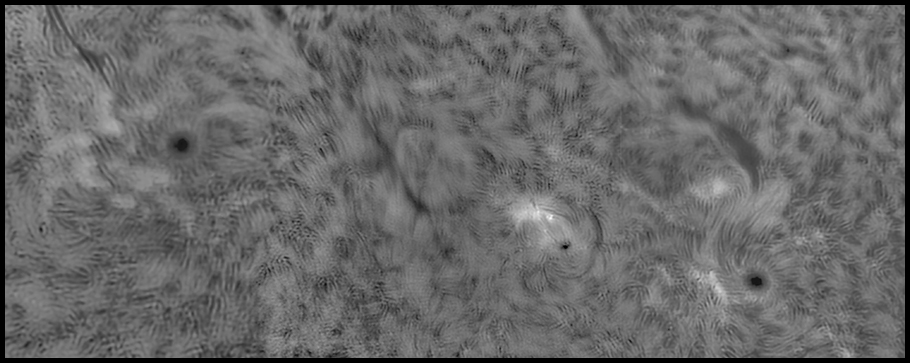In other news.
07/25/2022. Yesterday, I cleaned up the solar scope. I reduced the tilt of the sensor which I set long ago to eliminate Newton's rings. (Nope, putting it back, adjusting the other way, actually.) The current sensor is just a little larger and my expectations more than a little pickier, and I did this in the interests of wall to wall sharpness. I rotated the camera 90 degrees so the long dimension of the sensor runs east and west, and I retuned the quartz etalon for an improved balance of bandwidth and even illumination (effed that up, too, redid a couple of weeks later). Both could be improved since they were set before the introduction of live flatfielding. None of these changes has made much difference so far, but taken all together, like using deeper stacks of flats, they should lead to better results by and by.
Today, I made a new handle for the telescope. Sounds trivial, was very easy, but was also potentially important: it extends farther forward and finally lets me carry the OTA with a grip near the center of balance. With the old grip, I was never more than a moment's distraction from letting the objective rotate downward, threatening to wallop the steps, the porch, the ground, any convenient obstacle. And since I can just look to know where the center of gravity is, it should be easier to balance on the mount, too.
Also, worth acknowledging here: the ease with which I can set up and be imaging the Sun reminds me of the importance of that sort of availability. I want the same convenience for deep-sky imaging. More about the fallout from this inspiration is over in "The Starry Night" section. See pages 226-227 especially.
8/16/2022. My solar images have been noticeably degraded lately (so badly I didn't even save many examples; here's one that's better than most recent results since it's a very wide field, a three-frame panorama).

Best 400 out of 3,000 frames x 3
ROI 2000x2000
No point in making this one big. There's not a lot of fine detail to see.
I thought it might have something to do with the changes described above (because coincidences?) but now I think it's something else: the BG38 blue filter in the Lunt B600 blocking diagonal was compromised. The surface was pitted (that cleaned off) and the throughput noticeably wavy (that did not). What looked like watermarks also refused to be cleaned away. Online discussion holds that this might be moisture damage. So I've replaced the blue filter with a fresh one bought from a Chinese optical company via eBay a few years ago and stored sealed since then (I have two more when needed). And I resolve not to store the solar 'scope on the porch. While I was at it, I increased the tilt of the Newton's rings preventer -- maybe too much -- because they creeped back into the images after I reduced the tilt. They didn't quite go away when I put it back about where I found it. So I went further. Be sure everything stays in decent focus across a generous field of view, and back this off if need be. You can see where and how to do that because I'm currently using pennies for spacers(!). I ran out of room in the modified tilt mechanism and had to do something. Wait for some results and then see what's what.
Yow, that worked! See next page.
My deep-sky photos are made with a variety of sensors and optics. Deepest images come now from a ZWO ASI1600MM Cooled Pro CMOS camera, an ASIair (model 1) and sometimes one of several laptops. A good many images come from an unmodded Canon 6D but a lot more will be coming from an R6. Video and video extracts begin in a Canon EOS M, usually running in crop mode via Magic Lantern firmware (but the 6D and especially the R6 will probably see more use). Telescopes include an AT10RC, an Orion 10" F4 Newtonian, and a pair of apochromats: a TMB92SS and a AT65EDQ. A very early Astro-Physics 5" F6 gets some use, too. So do lots of camera lenses on both the ASI1600 and on the Canons. A solar Frankenscope made using a 90mm F10 Orion achromat and the etalon, relay optics, and focuser from a Lunt 60 feeding a small ZWO camera will see more action as the Sun comes back to life (Autostakkart!3 is my current fav for image stacking). Mounts include an iOpton SkyTracker (original model), a bargain LXD-55, a Losmandy G11 (492 Digital Drive), and an Astro-Physics Mach1. PixInsight does most of the heavy lifting; Photoshop polishes. Some of the toys are more or less permanently based in New Mexico. I desperately hope to get back soon.
:: top ::